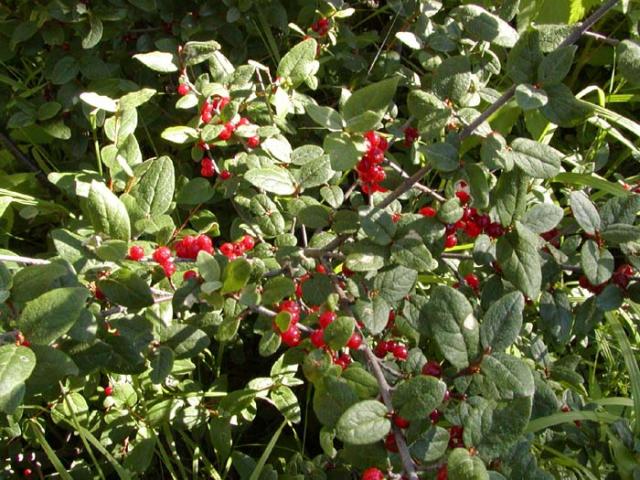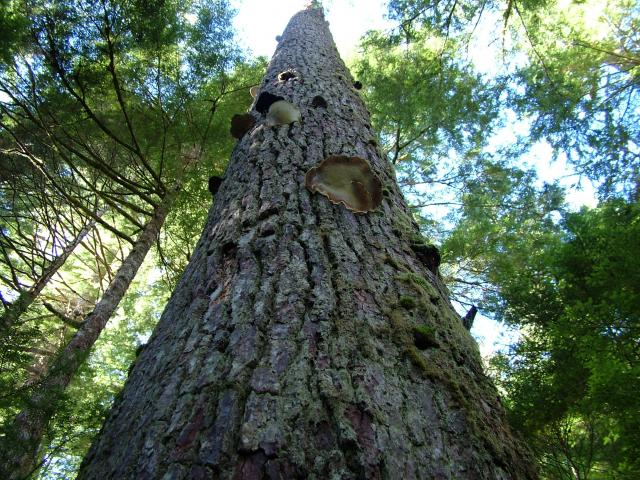User Login |
INTRODUCTION TO PRESENT AND FUTURE PLANTS
Kinnikinnick LATIN NAME: Arctostaphylos uva-ursi FAMILY: Ericaceae DESCRIPTION: Trailing evergreen ground cover, low growing (20 cm), with pale pink flowers, and bright red berries EDIBILITY: Berries edible, but not choice BODY SYSTEM AFFILIATIONS: Skin, Urinary System INDICATIONS: Vulnerary, Antiseptic, Astringent, Anti-inflammatory, Antilithic TRADITIONAL USES: The berries were used infusions for various medicinal purposes, but Kinnikinnick is most known for being added to smoking blends. The natives picked and dried the leaves and mixed them with tobacco for a sacred smoking blend. Soapberry www.ualberta.ca LATIN NAME: Shepherdia canadensis FAMILY: Elaeagnaceae DESCRIPTION: A dense, medium growing shrub (up to 6’), with simple, alternate leaves, bright yellow flowers, and bright red berries EDIBILITY: Berries edible, but not choice BODY SYSTEM AFFILIATIONS: Skin, Eyes, Digestive System, Hepatic System, Respiratory System INDICATIONS: Antihemorrhagic, Cathartic, Antiseptic, Stomachic, Opthamalic TRADITIONAL USES: Although the berries are very biter, they were mixed with salal, camas, hemlock cabmium for sweetener and whipped with a stick into a frothy dessert similar to meringue or ice cream. When mixed in water, the berries froth up and were used as a cleanser. Salal
LATIN NAME: Gaultheria shallon FAMILY: Ericaceae DESCRIPTION: Salal is n evergreen shrub that can grow to be 15 feet tall. It's leaves are thick and leathery, and it produces small white to pinkish flowers. The flowers make way for dark red to purple berries. It is tolerant of open sun and shady conditions, and forms very dense thickets. EDIBILITY: Berries edible, very delicious BODY SYSTEM AFFILIATIONS: none found INDICATIONS: none found TRADITIONAL USES: The berries of the salal plant were very important to almost all native groups of the northwest. The fruit was widely used for food, eating the fresh fruits in the summer and drying them or making them into preserves for the winter. Often used for trading as well. LATIN NAME: Chimaphila umbellata FAMILY: Pyrolaceae (wintergreen) DESCRIPTION: Pipsissewa is an evergreen shrub that grows up to .5 meters (about 1.5 feet) in dry shady woods. It produces alternate, serrated leaves and small white to pinkish flowers with 5 petals. EDIBILITY: none found BODY SYSTEM AFFILIATIONS: Respiratory system, urinary tract, nervous system, circulatory system INDICATIONS: antibacterial, astringent, diuretic, stimulant and tonic TRADITIONAL USES: Natives added pipsissewa to baths to soothe sore muscles, and used it in infusions for cold and influenza. It was used to induce fever and sweating, as well as topically for many skin ailments. Oceanspray
LATIN NAME: Holodiscus discolor FAMILY: Rosaceae DESCRIPTION: Oceanspray is a deciduous shrub that grows up to 4m (about 13 feet), with slightly hairy toothed leaves. It's small white flowers grow in large clusters, and the fruit is a small hairy seed pod. EDIBILITY: not edible BODY SYSTEM AFFILIATIONS: Digestive system INDICATIONS: diarrhea, measles, and chickenpox TRADITIONAL USES: It was known for how hard the wood is, and could be made even harder by burning it over a fire. It was used for many applications such as spears, digging sticks, bows and arrows, barbecuing sticks, and used as fasteners like nails in construction. Trailing Blackberry LATIN NAME: Rubus ursinus FAMILY: Rosaceae (Rose) DESCRIPTION: Trailing blackberry is a creeping vine that grows up to 15 feet long. The vine is covered in spines and the leaves grow in 3 leaflets. It produces small white flowers that make way for sweet black berries. EDIBILITY: Berries edible, very choice BODY SYSTEM AFFILIATIONS: Digestive system, female reproductive system INDICATIONS: diarrhea, dysentery, cholera, excessive menstruation, fevers, hemorrhoids and mouth sores TRADITIONAL USES: The fruits were picked by the natives and eaten fresh in summer time, and dried out for use as tea or added to cured meats to eat in the winter. The vines and leaves were also used in infusions for medicinal purposes. LATIN NAME: Xerophyllum tenax FAMILY: Liliaceae DESCRIPTION: Grows on dry slopes in forests. The hardy leaves of this grass grow out to about 4.5 feet long, getting shorter closer to the flower. The small white flowers grow in bunches on top of stalks that can grow up to 6 feet tall. It reproduces by seed as well as by sending offshoot from its rhizome. EDIBILITY: Flowers and leaves edible, but not choice BODY SYSTEM AFFILIATIONS: None found INDICATIONS: None found TRADITIONAL USES: When the leaves are dried, they turn a creamy white color. Natives would add dyes to the leaves and weave colorful baskets, hats, clothes and other useful items. The leaves and flowers were also boiled and eaten, but not very desirable. Pinus contorta var. latifolia LATIN NAME: Pinus contorta var. latifolia FAMILY: Pinaceae DESCRIPTION: A taller growing (up to 40 m) pine with paired needles; thin, red bark, and clustered seed cones EDIBILITY: Unknown BODY SYSTEM AFFILIATIONS: Circulatory System, Muscular/Skeletal System, Respiratory System INDICATIONS: Cardiac, Aromatic, Pectoral, Antirheumatic, open sores TRADITIONAL USES: The wood was used for firewood, making spears, fishing hooks, etc.; and the pitch was used for torches. The pitch was also used in many medicinal applications such as boiling and drinking as a cold remedy, or using as a salve externally to 'draw out the pain' from sore muscles. Douglas Fir LATIN NAME: Pseudotsuga menziesii FAMILY: Pinaceae DESCRIPTION: A tall growing (up to 70 m) tree with spiraled, yello-green needles and reddish brown seed cones EDIBILITY: Leaves, twigs, inner bark, resin BODY SYSTEM AFFILIATIONS: Skin, Eyes, Digestive System, Hepatic System, Respiratory System INDICATIONS: Antiseptic, Haemostatic, Antilithic, Cough Suppressent, Antiviral, Antifungal TRADITIONAL USES: The wood from the Douglas Fir was widely used for many things including: fuel for fires, spear handles, torches, utensils, caskets, halibut and cod fishing hooks, etc. The pitch was also used for sealing joints and holes in canoes, as well as a salve for wounds. |









